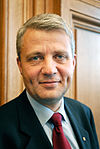2005 Norwegian parliamentary election|
|
|
|
|
First party
|
Second party
|
Third party
|
|
|

|

|

|
| Leader
|
Jens Stoltenberg
|
Carl I. Hagen
|
Erna Solberg
|
| Party
|
Labour
|
Progress
|
Conservative
|
| Last election
|
24.29%, 43 seats
|
14.64%, 26 seats
|
21.21%, 38 seats
|
| Seats won
|
61
|
38
|
23
|
| Seat change
|
 18 18
|
 12 12
|
 15 15
|
| Popular vote
|
862,757
|
582,284
|
372,008
|
| Percentage
|
32.69%
|
22.06%
|
14.10%
|
| Swing
|
 8.40pp 8.40pp
|
 7.42pp 7.42pp
|
 7.11pp 7.11pp
|
|
|
|
Fourth party
|
Fifth party
|
Sixth party
|
|
|

|

|

|
| Leader
|
Kristin Halvorsen
|
Dagfinn Høybråten
|
Åslaug Haga
|
| Party
|
Socialist Left
|
Christian Democratic
|
Centre
|
| Last election
|
12.55%, 23 seats
|
12.41%, 22 seats
|
5.56%, 10 seats
|
| Seats won
|
15
|
11
|
11
|
| Seat change
|
 8 8
|
 11 11
|
 1 1
|
| Popular vote
|
232,971
|
178,885
|
171,063
|
| Percentage
|
8.83%
|
6.78%
|
6.48%
|
| Swing
|
 3.72pp 3.72pp
|
 5.63pp 5.63pp
|
 0.92pp 0.92pp
|
|
|
|
Seventh party
|
|
|
|

|
|
| Leader
|
Lars Sponheim
|
|
| Party
|
Liberal
|
|
| Last election
|
3.91%, 2 seats
|
|
| Seats won
|
10
|
|
| Seat change
|
 8 8
|
|
| Popular vote
|
156,113
|
|
| Percentage
|
5.92%
|
|
| Swing
|
 2.01pp 2.01pp
|
|
|
 Results by county |
|
Parliamentary elections were held in Norway on 11 and 12 September 2005.[1] The result was a victory for the opposition centre-left Red-Green Coalition, which received 48.0% of the votes and won 87 out of 169 seats, dominated by the Labour Party's 61 seats. The three-party centre-right government coalition won 44 seats and the right wing Progress Party won 38, becoming the largest opposition party. Voter turnout was 77.1%, an increase of 2 percentage points compared to the 2001 elections.
Campaign
Before the election, Prime Minister Kjell Magne Bondevik led a coalition government consisting of the Conservative Party (38 seats in parliament), Christian People's Party (22 seats and supplied the prime minister) and the Liberals (2 seats), with the conditional support of the right-wing Progress Party. Between them, the three main parties of the coalition held 62 seats in the outgoing 165-seat Storting. The Progress Party held an additional 26, giving the four parties a majority when acting together.
Divisions within the coalition led to the temporary withdrawal of support by the Progress Party in November 2004, in response to what they saw as the government's underfunding of hospitals; an agreement was later reached. The government also attracted criticism for its handling of the 2004 Indian Ocean earthquake, in which several Norwegians died, with the prime minister admitting to mistakes in his government's delayed reaction to the disaster.
The question of private schools was controversial in 2005, with the opposition Labour Party, Socialist Left Party and Centre Party rejecting the government's plan to allow schools other than those offering an "alternative education", or those founded on religious beliefs, to become private.
Amidst a decline in the personal popularity of the prime minister, opinion polls in early 2005 indicated a clear lead for the Labour Party. Its leader, Jens Stoltenberg, was prime minister from March 2000 to October 2001, and enjoyed widespread public support in the run-up to the election. Polling suggests that the Labour, Socialist Left and Centre parties could form a red–green coalition, which would command a majority in the Storting. Labour and Socialist Left have pledged to maintain their allegiance with the Centre party even if the latter were not necessary to obtain a majority.
In June the leader of the Progress Party, Carl I. Hagen, said his party would not support a new coalition if Bondevik re-emerges as the prime minister after the election, implicitly pointing at Erna Solberg, leader of the conservative party as a better candidate.
A week before the elections, the Socialist Left Party experienced a fall in popularity on recent polls. The Liberals and Conservative Party gained popularity on the polls. As of 11 September 2005, the day before the election, the opinion polls indicated a dead run between the red-green coalition and the right wing.
Advance voting was possible from 10 August to 9 September. 452,488 votes were cast in advance, a decrease of approx 52,000 since the 2001 election.









